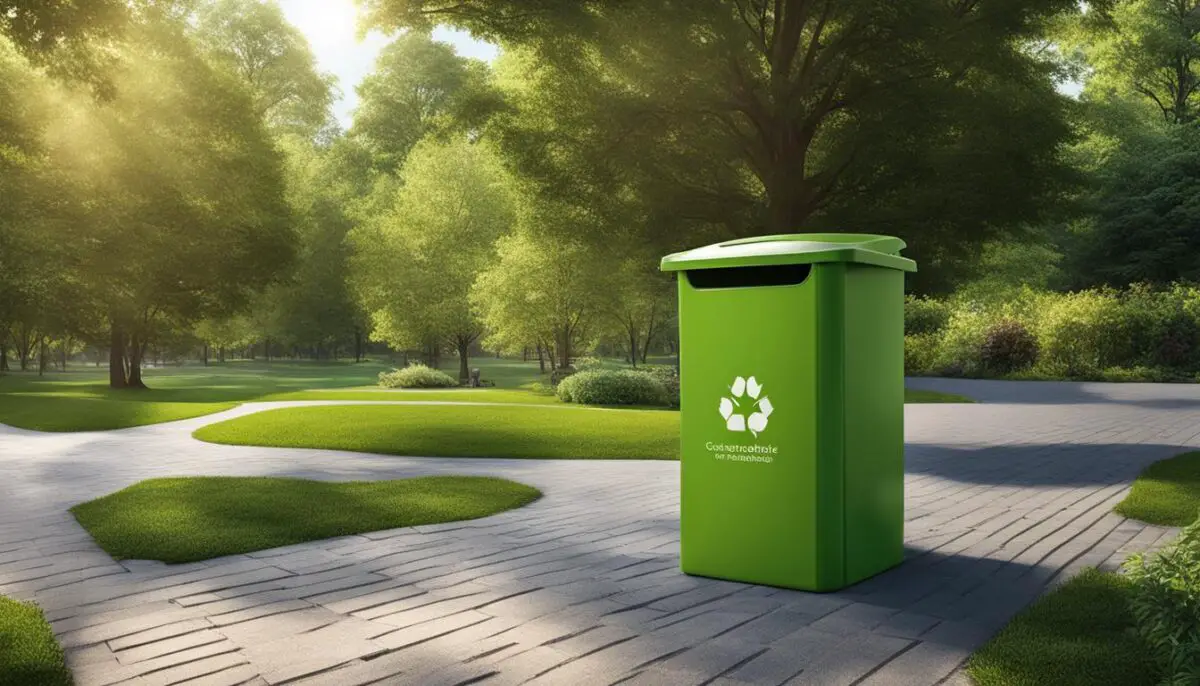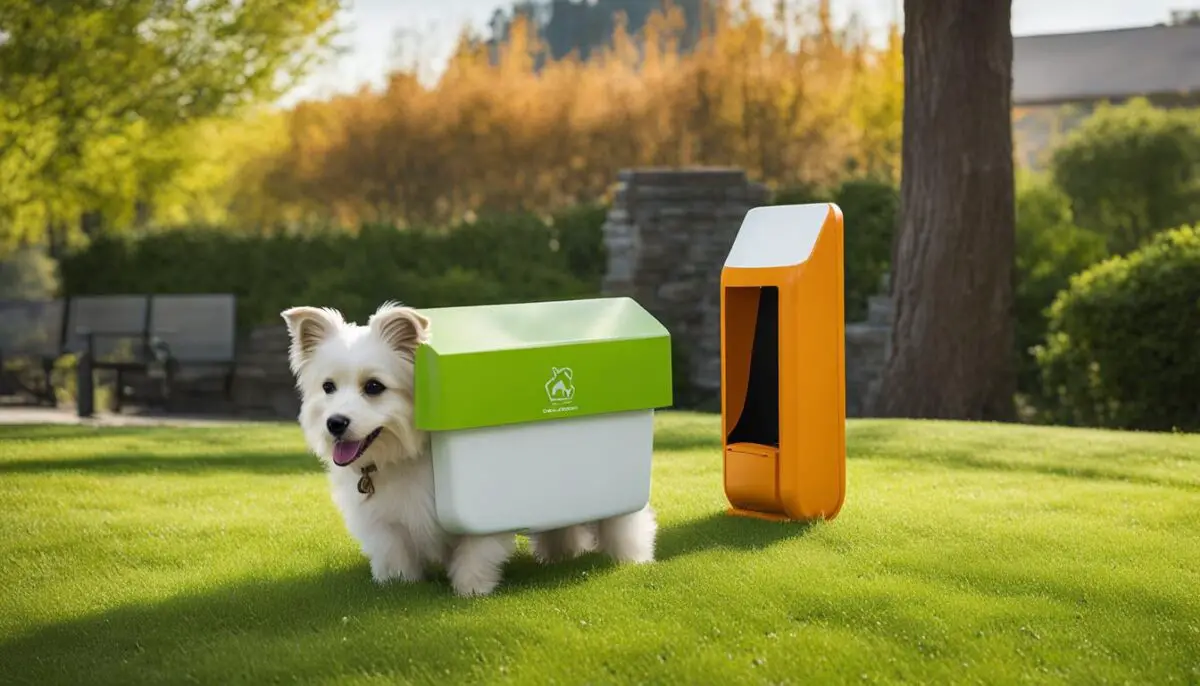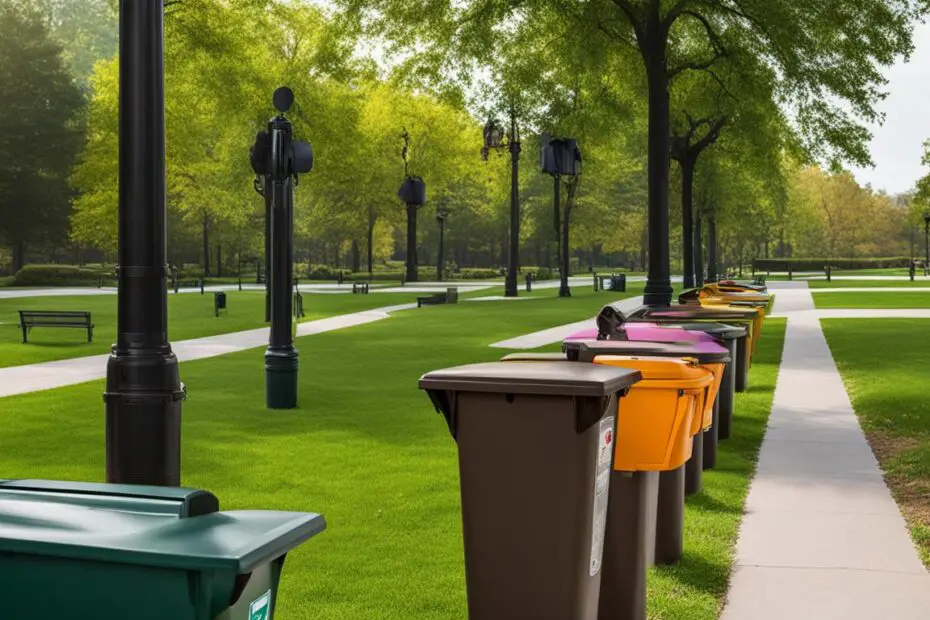Maintaining a clean and hygienic environment is crucial for both human and animal health, and this extends to the responsible disposal of dog waste. Unattended dog poop can become more than just an unsightly nuisance; it poses significant health risks, contributing to the spread of parasites and diseases, and adversely affecting the local ecosystem. The importance of effective dog waste management cannot be overstated, especially in communal spaces like parks and residential areas. Outdoor dog poop trash cans offer a practical and hygienic way to dispose of pet waste promptly, ensuring clean and safe yards and parks for everyone.
Key Takeaways:
- Proper dog waste management is essential for maintaining a clean and hygienic environment.
- Unattended dog waste can pose significant health risks and harm the local ecosystem.
- Outdoor dog poop trash cans provide a practical and hygienic solution for responsible pet waste disposal.
- Effective dog waste management is crucial in communal spaces like parks and residential areas.
- By investing in reliable dog waste bins, you can ensure clean and safe yards and parks for everyone.
The Problem with Dog Waste
Dog waste, when left unattended, poses significant environmental and health risks. It contributes to water pollution, as rainwater washes fecal matter into waterways, leading to increased nutrient levels and compromised water quality. In terms of health, dog waste is a breeding ground for harmful bacteria and parasites like E. coli, salmonella, and giardia. These pathogens can easily be transmitted to humans and other animals, causing diseases. Unmanaged dog waste in shared outdoor spaces diminishes their aesthetic appeal, presents a health hazard, and compromises the quality and enjoyment of these areas.
“Dog waste is not just a smelly inconvenience; it’s a serious problem that affects our environment and public health.”
The environmental impact of dog waste is alarming. One gram of dog waste can contain millions of fecal coliform bacteria, which can contaminate water sources and pose a risk to aquatic life. The excessive nutrient content from dog waste also contributes to algae blooms and depletes oxygen levels in water bodies, leading to the death of fish and other aquatic organisms.
In addition to causing water pollution, dog waste poses health risks to humans and other animals. Bacterial contamination from E. coli and salmonella can cause severe gastrointestinal illnesses in humans, while parasites like giardia can lead to diarrheal diseases. Children who play in contaminated areas are at higher risk of infection, as they often come into direct contact with the waste.
The environmental and health consequences of unmanaged dog waste cannot be ignored. It is imperative that pet owners and communities take responsibility for proper dog waste disposal to safeguard both the environment and public health.
Table: Health Risks and Environmental Impact of Dog Waste
| Health Risks | Environmental Impact |
|---|---|
| Bacterial contamination: E. coli, salmonella | Water pollution |
| Parasite transmission: giardia | Algae blooms |
| Spread of diseases to humans and animals | Depletion of oxygen levels in water bodies |

Types of Outdoor Dog Poop Trash Cans
When it comes to managing dog waste in outdoor spaces, there are several types of trash cans and disposal systems available. Whether you’re a pet owner or managing a community space, choosing the right dog poop bin is essential for effective waste management. Let’s explore the different options and their benefits.
Traditional Trash Cans
Traditional trash cans with lids are a popular choice for dog waste disposal. These bins are known for their simplicity and durability. They come in various sizes and materials, providing a secure and reliable solution to handle dog waste. With a sturdy lid, they help contain odors and prevent the spread of flies and pests.
Dog Waste Bins
Specially designed dog waste bins are tailored specifically for pet waste disposal. These bins often feature foot-operated lids, making them convenient and hygienic to use. Some models also include bag dispensers, ensuring dog owners always have bags readily available for waste disposal. The benefits of these bins include easy access, added convenience, and enhanced cleanliness.
Biodegradable Options
Promoting sustainability in pet waste management, biodegradable dog poop trash cans offer an eco-friendly alternative. These bins are made from materials that can naturally break down over time, reducing the environmental impact. Biodegradable options are an excellent choice for pet owners looking to minimize their carbon footprint and contribute to a cleaner planet.

Image Alt Text: Biodegradable dog waste bins
Each type of outdoor dog poop trash can has its own features and benefits, and the ideal solution may involve a combination of different types based on specific needs and preferences. Whether you opt for a traditional trash can, a dog waste bin, or a biodegradable option, choosing the right bin plays a crucial role in maintaining a clean and hygienic outdoor environment.
Placement and Maintenance
The effectiveness of outdoor dog poop trash cans relies on strategic placement and consistent maintenance. Whether you’re managing waste in your private yard or a communal space, following these tips will ensure a clean and odor-free environment:
- Ideal Placement: In private yards, place the trash can in a location that is easily accessible but not too close to living spaces to prevent odor issues. In communal areas, position the bins at entry/exit points, along popular walking paths, and in areas frequented by dogs.
- Strategic Placement: Consider the flow of foot traffic and dog walking patterns when positioning the bins. Strategic placement makes it convenient for users to dispose of dog waste while keeping the surrounding areas clean.
- Maintenance Tips:
| Maintenance Task | Frequency |
|---|---|
| Lining the bins | As needed |
| Using deodorizers | Regularly |
| Regular cleaning | Weekly |
| Ensuring lid maintenance | Ongoing |
| Regular emptying and cleaning schedules | Based on usage frequency |
Maintaining clean and odor-free outdoor dog poop trash cans not only promotes a healthy and hygienic environment but also encourages responsible pet waste disposal.

Buyer’s Guide: Factors to Consider When Purchasing an Outdoor Dog Poop Trash Can
When it comes to choosing the right outdoor dog poop trash can, there are several important factors that pet owners should consider. By taking these factors into account, you can ensure that you select a trash can that meets your specific needs and helps you maintain a clean and odor-free environment.
- Odor Control: Look for a trash can with effective odor control features to prevent unpleasant smells from spreading. This can include features such as a secure lid, airtight seals, or odor-neutralizing technologies.
- Capacity: Consider the size of your dog and the frequency of waste disposal. Choose a trash can with a capacity that is suitable for your pet’s waste volume. This will help prevent overflowing and minimize the need for frequent emptying.
- Durability: Select a trash can that is made from durable materials, such as high-quality plastic or metal, to ensure long-lasting use. This will help withstand outdoor elements and regular use without easily wearing or breaking.
- Ease of Use: Opt for a trash can that offers convenience and ease of use. Features like foot pedals for hands-free operation or easy-to-open lids can make the disposal process effortless and hygienic.
- Aesthetics: Consider the overall aesthetics and design of the trash can. Choose a style that complements your outdoor decor and seamlessly blends into the surroundings.
- Cleaning: Look for a trash can that is easy to clean. Removable liners or smooth surfaces can make the cleaning process hassle-free and ensure proper hygiene.
- Price: Lastly, consider your budget and the price range of the trash cans available. Find a balance between quality and affordability, ensuring that the chosen trash can fits within your financial means.
By considering these factors, you can make an informed decision when purchasing an outdoor dog poop trash can that aligns with your requirements. Remember, investing in a high-quality trash can will contribute to effective waste management, odor control, and a cleaner outdoor environment for both you and your furry friend.
Conclusion
Effective outdoor dog poop trash cans play a vital role in maintaining the cleanliness and hygiene of yards and parks. These bins provide a practical and convenient solution for responsible pet waste disposal, helping create a clean and safe environment for both humans and animals.
By considering the different types of dog poop bins available, understanding their features and benefits, and implementing proper placement and maintenance practices, pet owners and community managers can contribute to the overall cleanliness and sustainability of outdoor spaces. Responsible pet waste management is a shared responsibility that benefits everyone involved.
Remember, outdoor dog waste management is not only necessary for aesthetics but also for preventing health risks and environmental pollution. With the right dog poop bins and responsible pet waste disposal, we can ensure that our shared outdoor areas remain clean and enjoyable for all. Let’s do our part in keeping our surroundings clean and safe!
FAQ
Why is it important to properly manage dog waste?
Properly managing dog waste is crucial for maintaining a clean and hygienic environment. Unattended dog poop can pose significant health risks, spread parasites and diseases, and negatively impact the local ecosystem. It is essential for the health and well-being of both humans and animals.
What are the risks associated with unmanaged dog waste?
Unmanaged dog waste contributes to water pollution, increases nutrient levels in waterways, and compromises water quality. It also serves as a breeding ground for harmful bacteria and parasites like E. coli, salmonella, and giardia, which can be transmitted to humans and other animals, causing diseases.
What types of outdoor dog poop trash cans are available?
There are various types of outdoor dog poop trash cans available, including traditional trash cans with lids, specially designed dog waste bins with foot-operated lids and bag dispensers, and biodegradable and compostable options. Each type offers its own advantages and benefits.
Where should outdoor dog poop trash cans be placed and how should they be maintained?
In private yards, it is best to place outdoor dog poop trash cans in a location that is easily accessible yet not too close to living spaces to avoid odor issues. In communal areas, the bins should be placed at entry/exit points, along popular walking paths, and in areas where dogs are commonly walked. Regular maintenance includes lining the bins, using deodorizers, regular cleaning, lid maintenance, and establishing regular emptying and cleaning schedules based on usage frequency.
What are some innovative solutions and accessories for managing dog waste?
There are odor-neutralizing bags and liners infused with activated charcoal or scents to contain and neutralize odors. Smart bins with sensors and notification systems enable timely emptying and prevent overflow. Eco-friendly alternatives like compostable bins and worm farms promote environmental sustainability.
What factors should be considered when purchasing an outdoor dog poop trash can?
Factors to consider include odor control, capacity matching the size of the dog and frequency of waste disposal, durability, ease of use such as foot pedals for hands-free operation, aesthetics that blend with outdoor decor, ease of cleaning, and price based on budget and specific needs.
Why is responsible pet waste management important?
Responsible pet waste management is a shared responsibility that benefits everyone. It ensures clean and hygienic yards and parks, promotes a safe environment for both humans and animals, and contributes to overall cleanliness and sustainability in outdoor spaces.
